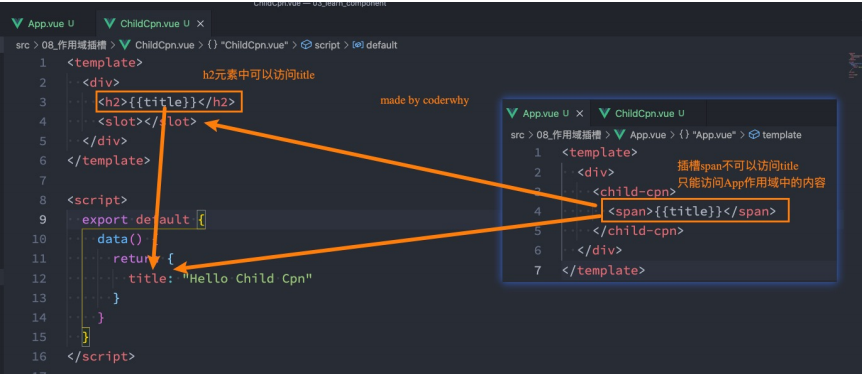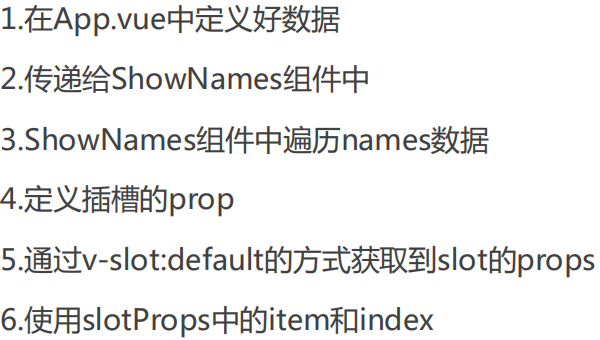Let's get to know the slot first
In development, we often encapsulate reusable components:
- Previously, we'll pass some data to the component through props so that it can be displayed.
- However, in order to make this component more versatile, we cannot restrict the contents of the component to fixed div, span, and so on.
- We should allow users to decide what content and elements to store in an area.
How to use slot?
- In fact, the process of using the slot is to extract common features and reserve different ones.
- We will still encapsulate the common elements and contents within the components.
- At the same time, slot s are used as placeholders for different elements, allowing the outside to decide what elements to display.
- In an encapsulated component, a slot can be opened for the encapsulated component using a special element.
- What the slot inserts depends on how the parent component is used;
Basic use of slots

App.vue
<template>
<div>
<my-slot-cpn>
<button>I am a button</button>
</my-slot-cpn>
<my-slot-cpn>
<my-input-cpn />
</my-slot-cpn>
<h2>I am not a component of the slot</h2>
<my-slot-cpn>
<h4>Lots of stuff in the slot</h4>
<i>Do you trust me?</i>
<del>Come on.</del>
</my-slot-cpn>
<my-slot-cpn></my-slot-cpn>
</div>
</template>
<script>
import MySlotCpn from "./MySlotCpn.vue";
import MyInputCpn from "./MyInputCpn.vue";
export default {
name: "App",
components: { MySlotCpn, MyInputCpn },
methods: {},
};
</script>
<style scoped>
</style>
MySlotCpn.vue
<template>
<div>
<h3>Start of component</h3>
<slot>
<i>I am a slot, no information is filled in, I am the default</i>
</slot>
<h3>End of component</h3>
</div>
</template>
<script>
export default {};
</script>
<style lang="scss" scoped>
</style>
MyInputCpn.vue
<template>
<div>
<input type="text" placeholder="I'm an input box" />
</div>
</template>
<script>
export default {};
</script>
<style lang="scss" scoped>
</style>
Use of named slots - dynamic slot names
- A named slot, as its name implies, gives the slot a name, and the element has a special attribute: name.
- A slot without a name, with the implied name default;
We can dynamically bind a name via v-slot:[dynamicSlotName];
Abbreviations for named slots:
Like v-on and v-bind, v-slot has abbreviations;
That is, replace everything before the parameter (v-slot:) with the character #;
<template>
<div>
<nar-bar :name="name">
<template v-slot:left> I am the slot on the left </template>
<template v-slot:center>I am the middle slot</template>
<template v-slot:right>I am the right slot</template>
<template #[name]>I am a grammar sugar and dynamic slot </template>
</nar-bar>
</div>
</template>
<script>
import NarBar from "./NarBar.vue";
export default {
name: "App",
data() {
return {
name: "lisi",
};
},
components: {
NarBar,
},
};
</script>
<template>
<div>
<div class="nav-bar">
<div class="left"><slot name="left"></slot></div>
<div class="center"><slot name="center"></slot></div>
<div class="right"><slot name="right"></slot></div>
<div class="name"><slot :name="name"></slot></div>
</div>
</div>
</template>
<script>
export default {
props: {
name: String,
},
};
</script>
Render Scope
There is a concept of rendering scope in Vue:
- All content in the parent template is compiled in the parent scope;
- Everything in a sub-template is compiled in a sub-scope;
List

Understanding Scope Slot
But sometimes it is very important that we want the slot to have access to the contents of the subcomponents:
- When a component is used to render an array element, we use a slot, and we want the slot to display nothing for each item.
- This Vue provides us with a scoped slot;
Use steps

ShowNames.vue
<template>
<div>
<template v-for="(item, index) in names" :key="item">
<slot :item="item" :index="index"></slot>
<slot name="lisi"></slot>
</template>
</div>
</template>
<script>
export default {
props: {
names: {
type: Array,
default: () => []
}
}
}
</script>
<style scoped>
</style>
App.vue
<template>
<div>
<nar-bar :name="name">
<template v-slot:left> I am the slot on the left </template>
<template v-slot:center>I am the middle slot</template>
<template v-slot:right>I am the right slot</template>
<template #[name]>I am a grammar sugar and dynamic slot </template>
</nar-bar>
<hr />
<show-names :names="names">
<template v-slot="names">
<p>{{ names.item }}-{{ names.index }}</p>
</template>
</show-names>
<hr />
// If we have default and named slots, then follow the full template
<show-names :names="names">
<template v-slot="slotProps">
<span>{{ slotProps.item }}---{{ slotProps.index }}</span>
</template>
</show-names>
<hr />
// If only the default slot is in our slot, the label of the component can be used as a template for the slot, so that we can use v-slot directly on the component
<show-names :names="names" v-slot="slotProps">
<button>{{ slotProps.item }}-{{ slotProps.index }}</button>
</show-names>
<hr />
<show-names :names="names">
<template v-slot="slotProps">
<button>{{ slotProps.item }}-{{ slotProps.index }}</button>
</template>
//If our slot is default, v-slot:default="slotProps" can be abbreviated as V slot="slotProps" when used:
<template v-slot:lisi>
<h2>I am name Insertion of</h2>
</template>
</show-names>
</div>
</template>
<script>
import NarBar from "./NarBar.vue";
import ShowNames from "./ShowNames.vue";
export default {
name: "App",
data() {
return {
names: ["Zhang San", "Li Si", "King Five", "Zhao Six", "Sun Qi"],
};
},
components: {
NarBar,
ShowNames,
},
};
</script>